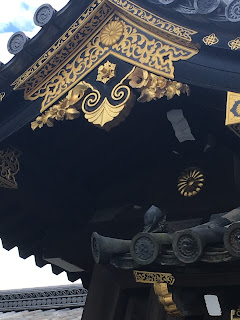Before the Edo Period, Kyoto was the capital city of Japan. There is an imperial palace there (which I have not been to), but also the Shogun's castle, called Nijo Castle. Built around 1603, burned and restored a few times, this castle is quite large and has both fortifications and pleasant gardens.
I'm going to have to break this up into a few posts.
 |
| This is the Higashi Ote-mon, or the East Gate. It used to be a 2-storied gate, but that was changed when the emperor visited; you see, no one could look down at the emperor. |
 |
| This is the Ban-sho, where the guards were stationed |
 |
| This is one of the towers. |
 |
| The Southeast Watchtower, I think. It is one of only two that survived fires. |
 |
| This is the wall of the Ninomaru, which... I think means Outer Palace? It's one of the two palaces inside the castle walls. |
 |
| This is the Karamon Gate, the gate that goes into the Ninomaru. It's beautiful! See the next pictures for the designs. |
 |
| That flower in gold is the symbol of the imperial family. |
Anyway, that was the Karamon Gate. The Ninomaru Palace was fascinating, but we weren't allowed to take pictures inside.
Outside, we saw these two bells, and I have to be honest, I don't remember what they were for:
For the sake of completion, I'm going to summarize the three parts I remember best about the Ninomaru.
First, it was the home of the Shogun when he lived in Tokyo, so it was very artfully decorated. All the rooms had paintings, and as you walked in a circle around the inside, it was like walking through the four seasons. I definitely remember seeing tigers and leopards in the paintings--neither of which are native to Japan. I heard one story that the Shoguns believed the tiger was a male and the leopard was a female of the same species (or was it the other way around?) and there was one painting that showed a leopard nursing two leopard cubs and a tiger cub.
Second, there was a hallway called... I think... the Corridor of Nightingales. (Nightingale Corridor? Nightingale Hallway? Something like that.) Whenever someone walked on the floorboards,they would creak, and sound like singing nightingales.
Third, and most relevant for me, this was the building where the Tokugawa Shogun first dismissed all the Samurai and then released power to the Meiji Emperor. This was the building where the age of the Shoguns ended. (That's what the tour guide said, anyway.)
Well, that's the first half of Nijo Castle! Check back later for more, because oh wow is there more.








No comments:
Post a Comment